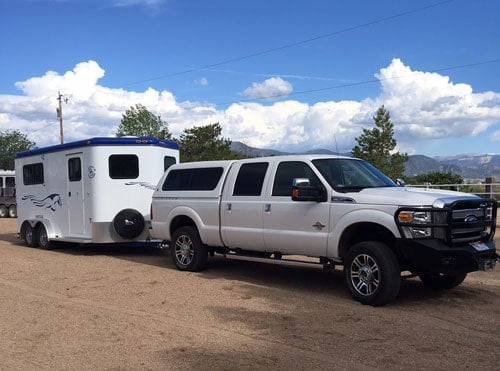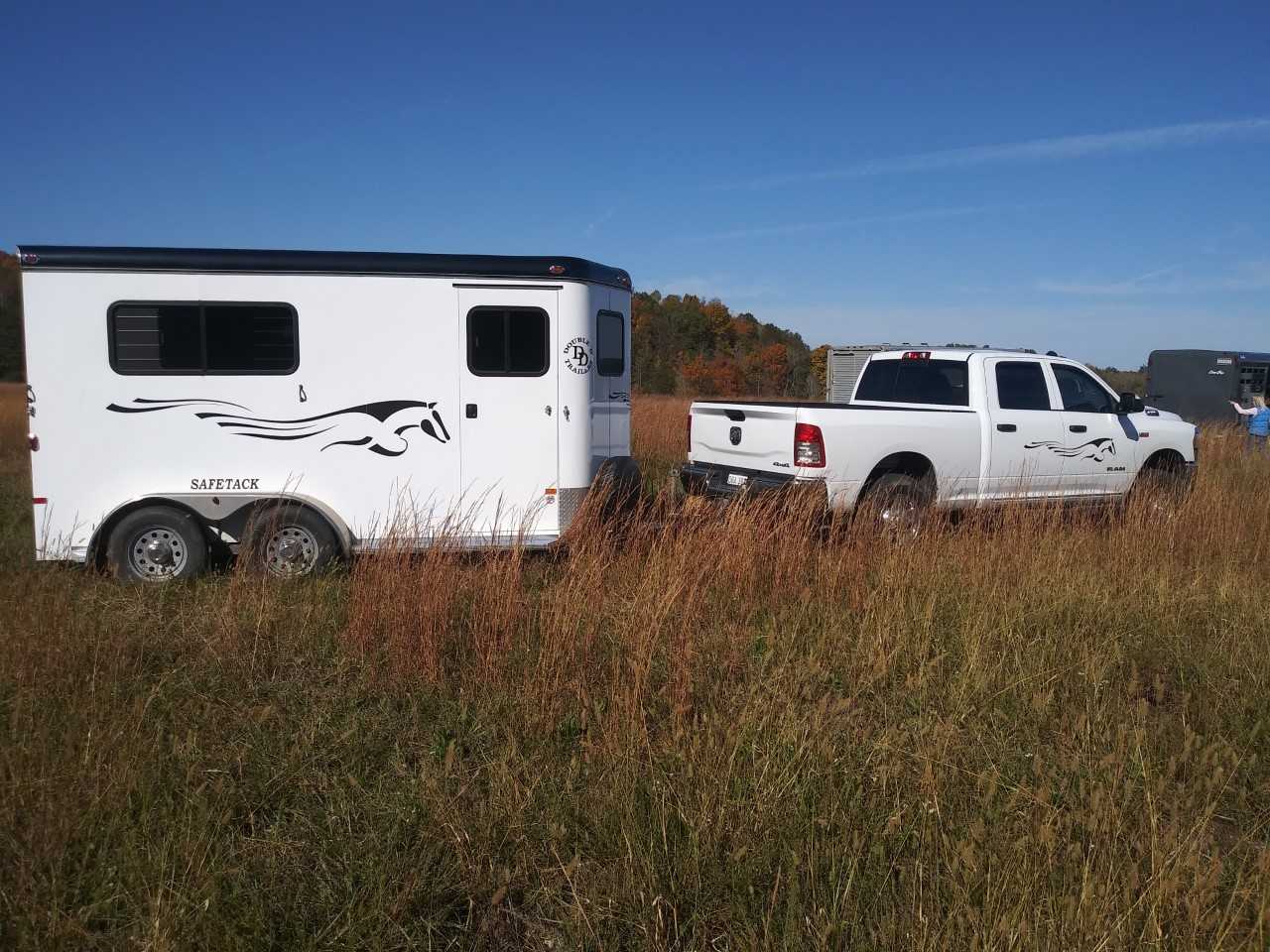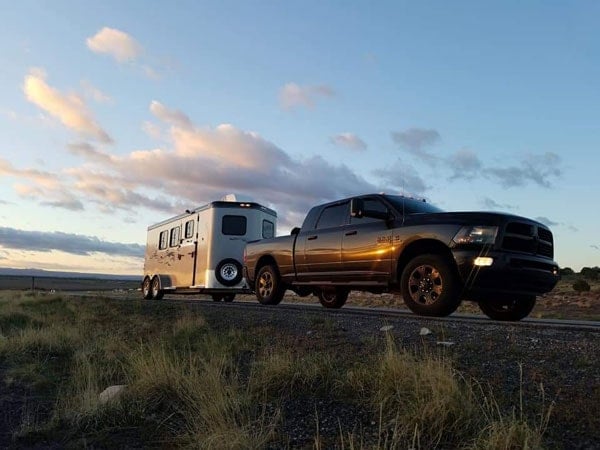How to Hook Up a Bumper Pull Horse Trailer Like a Pro
Knowing how to safely hook up a Bumper Pull Horse Trailer and tow it properly gives you the freedom to safely travel anywhere you like with your horses. Brad Heath, the owner of Double D Trailers, feels this topic can never be ‘over-discussed’. “Each day, horse owners across the US continue to hitch up with unsafe loads,” he explained.

Step 1: Make Sure Your Tow Vehicle is Adequate to Haul Your Load
The art of properly hitching up any horse trailer all starts with checking the numbers first. This is how Brad sums up the information you need to be aware of before proceeding with hooking up your Bumper Pull Horse Trailer. Brad went on to explain what he calls the “1-2-3s” of trailer load safety.
1) Determine both the tongue weight and overall weight of your Bumper Pull Horse Trailer.
If you are unsure of your trailer's weight, physically go to a commercial scale station and have it weighed. This usually costs about $5.00 and takes about five minutes. Don’t bother looking for this information on your trailer’s decal sticker because manufacturers never list the necessary values.
Example: You may find that your 2-horse Bumper Pull Horse Trailer weighs 3,400 lbs. and has a vertical tongue/hitch weight of around 600 lbs.
2) Check your tow vehicle’s weight towing capacity along with the tongue weight capacity on your hitch.
An important thought to remember when learning how to hook up a Bumper Pull Horse Trailer is that having the wrong numbers could be worse than having no information on this matter at all. When it comes to your tow vehicle’s weight towing capacity and the tongue weight capacity of your hitch, don’t rely on an auto or trailer dealer to advise you on this matter. They are notorious for providing wrong information.
Example: You may find that your vehicle is capable of towing 8,000 lbs., and the tongue weight hitch capacity is 800 lbs. (This value typically ranges from 800 to 1,500 lbs.)
3) Compare the tongue weight of your Bumper Pull Horse Trailer to the tongue weight capacity on your tow vehicle’s hitch.
Keep in mind that if you don’t exceed the stated capacity when fully loaded - you are safe. Also, compare the overall weight of your Bumper Pull Trailer to the overall weight towing capacity of your vehicle.
Examples: Your vehicle can tow 8,000 lbs., and your trailer weighs 3,400 lbs. Your tongue weight capacity is 800 lbs. and your actual tongue weight is 600 lbs., so you’re okay in both cases.
If you determine that your tow vehicle or hitch are not adequate to hook up your Bumper Pull Horse Trailer and haul the load, then you need to upgrade either your vehicle or your hitch. Weight distribution systems (sway bars) are needed on some trailers and tow vehicles to be within the safe towing range.
Adding weight distribution to a Bumper Pull Horse Trailer will help with stability, but can be a bit of a nuisance to connect the first time. Once you become familiar with the system, it will get easier each time you go through the routine. Brad recommends going to an RV/Camper center for information on weight distribution or sway bars. “Almost every camper that rolls out requires them!”, he says.
Step 2: Know Your Hitching Connection Parts
Now that you know your vehicle and hitch are sufficient to hook up and tow your Bumper Pull Horse Trailer, familiarize yourself with the connection parts. First, let’s look at the important components that should be installed on the tow vehicle.
Hitch Connection Parts on Your Tow Vehicle
Which are the important parts of a tow vehicle’s trailer hitch setup? Let’s take a look:
• Receiver
This is the square tubing that‘s bolted to the frame of your tow vehicle. It normally has a 2” dimension.
• Ball Mount
You will purchase this portion separately and it will slide into the receiver. Ball mounts are available in straight, drop, or adjustable versions.
• Ball
The ball is attached to the end of the ball mount and is the part that actually connects to your trailer.

Hitch Connection Parts on Your Bumper Pull Horse Trailer
What are the essential hitch connection parts of a Bumper Pull Horse Trailer? All of the items we’ve listed below must be of superb quality and should meet all relevant safety standards. Above all, they need to be fitting for the trailer’s dimensions and weight.
• Coupler
This is the part that physically connects to the ball on your truck’s hitch. Most Bumper Pull Horse Trailers come with an ‘A-Frame’ coupler shaped like the letter ‘A.’ Couplers will be designed for a 2” or 2 5/16” ball. Brad explained, “All Double D Trailers use a 2 5/16" size coupler which is the largest size (and greatest capacity) available. There are countless brands of couplers and the majority differ in the manner in which they latch.”
• Safety Chains and Cables
If your Bumper Pull Horse Trailer becomes disconnected from the ball, it's important to have the safety cables fastened to the receiver, which is bolted to the vehicle chassis. Brad prefers safety cables that coil like a pig’s tail over chains because the tension on the coil prevents the cable from becoming disconnected. Safety chains are more likely to dangle or even drag on the highway. There is a higher risk of safety chains becoming disconnected during travel.
• Wiring Harness
All the electronic wires needed to operate your Bumper Pull Horse Trailer’s brake lights and turn signals will be encased in the wiring harness. It will be plugged directly into the rear bumper of your tow vehicle. Newer style vehicles have a 7-prong flat connector that acts as a universal plug for all RVs and trailers. The wiring harness will not operate your trailer’s brakes unless you have a brake controller installed in your tow vehicle.
• Emergency Breakaway System
This final component is designed to automatically engage the brakes of your Bumper Pull Horse Trailer in case your trailer becomes disconnected from your tow vehicle. It’s best to connect this cable to the receiver hitch or the same place as your safety chains. Once the cable pulls "out" from the breakaway system, this activates the trailer brakes. Regarding trailer brakes, it's important the emergency breakaway system battery stays fully charged at all times. Otherwise, if your trailer becomes disconnected, the system will not function.
Step 3: Hook Up Your Bumper Pull Horse Trailer
Hooking up your Bumper Pull Horse Trailer can be a little tricky if you’re just learning, but gets easier with practice. Specifically for bumper pull trailer models, it is often helpful to have an extra person standing near the trailer coupler to help guide the driver as they back into position.
Once the ball is positioned directly below the coupler, lower the trailer down onto the ball until it locks into position. Be sure that you’ve made a secure connection between the ball and the coupler. Here’s an important note: Improper connections here are the most common mistake when it comes to hooking up bumper pull trailers!
“When the coupler never fully engages properly around the ball, the coupler pre-maturely locks sitting on top of the ball, rather than clawing around the ball,” Brad shared. “So the first major bump you go over could suddenly cause the trailer to bounce off the ball.”
At this point, the safety chains would prevent your Bumper Pull Horse Trailer from becoming fully disconnected. Still, a disconnected ball and coupler can be a scary experience.
“We had a client call us about two years ago and said something was wrong with her bumper pull hitch. She was pulling out of her driveway and she said it suddenly popped off the ball and fell to the ground (or until the safety cables caught it). It made a lot of noise and shook her up when it happened. She simply didn't connect it properly. Thankfully, she was only in her driveway”.
Brad feels confident in recommending hooking up a Bumper Pull Horse Trailer behind any adequately equipped tow vehicle that is rated to safely carry the load. “With the correct vehicle equipped with a weight distribution system, towing a load that doesn't exceed the vehicle's towing specs, Bumper Pull Horse Trailers are very safe”.
Final Thoughts
It’s crucial to learn how to hook up your Bumper Pull Horse Trailer the right way. Always double-check your connection and make sure the ball is securely set and locked into the trailer’s coupler.
Midway through a long trip, you should also pop back and make sure that the safety cables or chains haven’t become unhooked from the receiver hitch. Next, double-check the wiring harness connection, especially on older vehicles. Often, the female portion on the tow vehicle becomes worn so the male plug will "fall out" while traveling.
These safety practices along with towing checks will go a long way to ensure you have safe and enjoyable adventures traveling with your horses. If you have more questions or need additional consultation on which type of Bumper Pull Horse Trailer is right for you and your horses - contact our Double D Trailers team.


